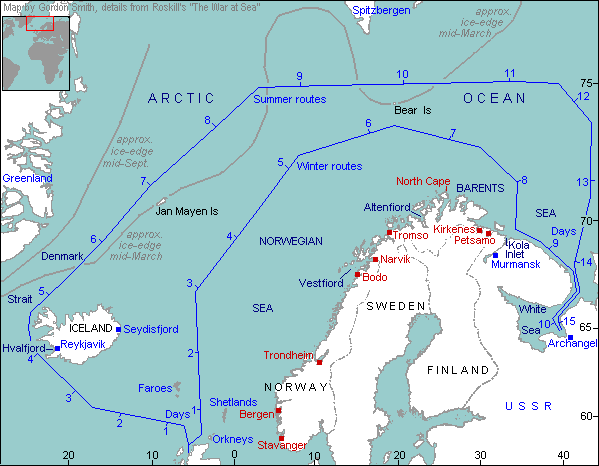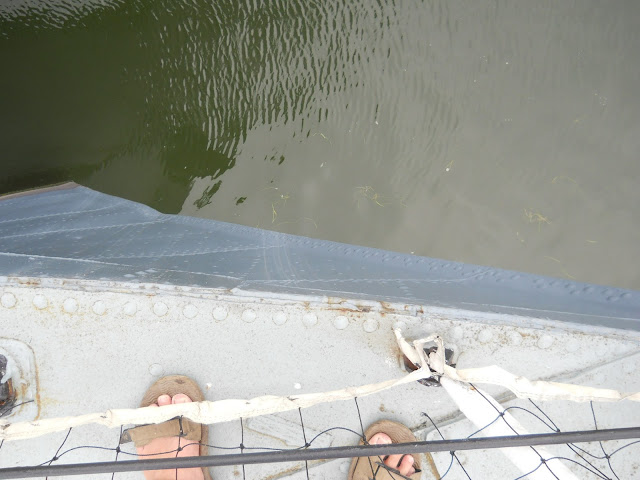 |
| HMCS Haida, the last extant Tribal-class destroyer, leaving its berth next to National Yacht Club in 2002 and heading for Hamilton Harbour. |
Some things are unlikely to be known with certainty, but I do know that my father's World War II service as a seaman on British Merchant Navy ships took him on the dreaded "Murmansk run" in order to to supply Russian allies with needed goods and war materiel, and that the Canadian destroyer HMCS
Haida was on the same run. At the same time as my father's runs? I can't say, but for the sake of literary licence, I'll believe it.
 |
| A bridge not yet far enough up. |
Now, having posited the not easily verifiable, but easily possible, conjunction, I'll move to the factual and note how it's funny how the Venn diagrams of personal history and History with a capital "H" cross. We sailed a couple of weeks ago to Hamilton, ON,
a largish city I had never visited by sailboat, despite its proximity to our home port, or perhaps because of that. We were attending a very nice backyard party/jam session thrown by some transplanted-from-Toronto friends. It was also my birthday weekend, and, like a good co-captain, my wife gave me
a new chart of Hamilton Harbour.
 |
| If yours is the only boat requiring passage under the bridge, the operators waste no time lowering back to the road level. |
Hamilton has a large, protected and deep natural harbour; it's no surprise that it became a centre of heavy industry. The protected aspect comes from the harbour being almost completely bounded by artificial moles under elevated highways and roads, the whole pierced by
a short but turbulent ship canal spanned by a
large lift bridge.
Now, aside from a stellar and much-appreciated chance to steer downwind both there and back (we set a new SOG record of 9.2 knots (!) surfing on the return leg), we got to see a few Hamilton sights of note, such as
Brewers Marine Supply, a rather old-school chandlery where I left my PLB for battery replacement, and we walked from the very pleasant
Royal Hamilton Yacht Club to visit
HMCS Haida, now a museum ship and the last extant Tribal-class destroyer from World War II.
As said above, my connection to this particular ship is tenuous, but real, or at least plausible. My late father,
of whom I've spoken in this blog before, participated in World War II as a teenaged British merchant navy sailor; he was just 20 in 1945, and so had what can only be described as a highly eventful youth. Despite the fact that many of his comrades and friends met unpleasant ends thanks to U-boats and horrible weather, while serving on rapidly and perhaps insufficiently built ships, and the real possibility of death-by-torpedo, he generally had a fairly happy war, centered, as he often said, on the absence of food rationing aboard Merchant Navy ships.
 |
| Still in the top 10 list of "unpleasant yet essential" as far as I can tell |
One thing he did not enjoy recalling, however, was the exceedingly dangerous convoy duty he served making the so-called "
Murmansk run". With the USSR as an ally during World War II, Britain, Canada and the U.S. strove mightily to supply the Russians with food, fuel and the precious war
materiel needed to beat the vast German land forces on the Eastern front. This meant reaching
Russia's most northerly port, one acceptably distant from the front lines, and yet one also ice-free and served by rail.
 |
| A colourized example of the sort of constant effort to remove the heavy frozen ice from the ship's decks. |
The attrition in men and ships was appalling on this particular frosty convoy route. German
long-range spotter aircraft were easily able to patrol the route based as they were out of Norway, and weather bad enough to ground them was also liable to sink the freighters in convoy due to heavy ice accumulation and the resultant sudden, devastating capsize. My father commented he was rarely more motivated to labour aboard than when he and the rest of the crew had to knock...with hammers and axes...
frozen sea water off the decks and superstructure of his ship in order to avoid a fatal top-heaviness.
 |
| The right side matches the description of what I heard from my father. |
Enter
HMCS Haida.
Built to a British design, this jack-of-all-trades destroyer class served in various navies, including the Royal Navy, the Royal Canadian Navy and the Australian Navy. They proved to be tough (
Haida was particularly bellicose in her service) and reliable, and provided some measure of protection to the merchant shipping under their care.
 |
| HMCS Haida in 2002 being towed from next door to our club to its currrent berth in Hamilton, Ontario. I recall seeing this. |
Although I do not have current access to my father's MN paybook to confirm this, it is very likely that he would have been in one of those ships protected by
Haida and its sister-ship,
Huron. Thus, my father's survival to breed me, some 16 years after the end of World War II, made a visit to see
Haida more personal than most touristic days out.
 |
| As HMCS Haida would have appeared during World War II. |
The strange thing is that
Haida was berthed for most of my life (she was decommissioned in the early '60s) not only in Toronto, but opposite
our present boat club. She sat immobile, tied up and quietly rusting and barely avoiding the scrapyard, a short walk away, and neither I nor my father saw fit to visit her. Towed to become a permanent museum ship to Hamilton some 10 years ago, I deemed it a "must-see", and a very interesting visit it proved to be.
 |
| Mrs. Alchemy and Cabin Boy Extraordinaire, shown to scale |
Without
spoiling it for those readers inclined to visit (which we would suggest is a very good idea), it does bring home how large and complex a vintage destroyer can be, and at the same time how basic were the wartime facilities aboard.
 |
| I'm guessing that the low steel wall here is to divert breaking seas and to keep snapped anchor chain from taking off the legs of crew further aft. |
Haida is not entirely at present as she would have appeared if my father had viewed her from a convoy ship's bridge un 1943. She served well into the Cold War, and still sports radar and guns from that time. But enough of her is pure World War II to get a sense of how life aboard her must have been.
 |
| Your correspondent's toes contemplating the sheer at the bow. |
My hairy little son seemed to get into the spirit of the thing, shouting various warlike invective in his unbroken voice.
 |
| I'm not sure destroyers ever called for "RAMMING SPEED" from the aft bridgedeck. Perhaps. |
 |
| "Captain requests shellfire to be deposited just over there." |
 |
| ICOM Model 1 VHF, circa 1956 |
 |
| Some mortal coils. |
The Captain's quarters were Spartan at best, although I liked the look of the instruments.
 |
| Acceptably firm, as per regulation. No lee boards seen. |
 |
| What? No Zulu time? |
The highlight for me, being of a mechanical bent, if one acquired late in life, was a visit below. Yes, I should have used more flash.
 |
| This is how the analog world worked, kid. |
|
|
One of the volunteers in the engine room was a woman who believed herself to be the first female stoker in the Canadian navy. She was exceptionally well-versed on the equipment, and when I enquired whether the steam turbines were the
Parsons type, she got quite animated and allowed me to peer into...and touch...the enormous blades of the turbines.
 |
| I can only imagine this woman's backstory. She knew every inch of this vast and complex space. |
The idea of any of the surrounding piping or engine parts, filled with high-pressure, superhot steam, bursting during wartime, was sobering indeed.
 |
| Note the cotter pins on the mounting stud nuts. Cheap insurance! |
I enjoyed the visit to
Haida very much, as did the family, and even if you lack a tenuous connection to its history, who wouldn't want to sit on a deactivated torpedo?
 |
| Well, they said it was deactivated. |
























